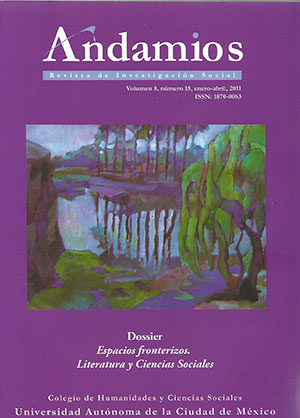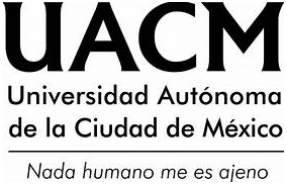STORIES OF VIOLENCE IN THE WORKS OF SERGIO GONZÁLEZ RODRÍGUEZ
DOI:
https://doi.org/10.29092/uacm.v8i15.69Keywords:
Narrativas de la violencia, estudios culturales, narcotráfico, crisis de Estado, feminicidios, lógica depredadoraAbstract
Summary: This article explores representation of violence in contemporary Mexico in three books by Sergio González Rodríguez. In his journalistic accounts as well as in other of his books, he approaches the homicides against women in Ciudad Juárez, the drug trafficking cartels and recent beheadings, in order to encompass a broader consideration of violence as a global phenomenon that exceeds Mexico. Thus his interdisciplinary analysis offers a model to rethink recent Mexican violence in relation to the crisis of the National State, its Judicial system, and its politics, vis-a vis processes of globalization. Key words: Narratives of violence, drug trafficking, demise of State, Women’ homicides, predatory logic.
Downloads
References
ASTORGA, L. (1996), El siglo de las drogas, México: Espasa Calpe.
BARTHES, R. (1997), El grado cero de la escritura, México: Siglo XXI.
BLANCO, J. J. (2002), Álbum de pesadillas mexicanas, México: Era.
BURGH, H. de (ed.) (2000), Investigative Journalism: Context and Practice,
Londres-Nueva York: Routledge. FINNEGAN, W. (2010), “Letter from Mexico. Silver or Lead”, en The New
Yorker, 31 de mayo, Nueva York: Condé Nast Publications, pp. 39-51.
GONZÁLEZ RODRÍGUEZ, S. (2002), Huesos en el desierto, Barcelona: Anagrama.
__________ (2008), El vuelo, México: Random House Mondadori.
__________ (2009), El hombre sin cabeza, Barcelona: Anagrama.
HURTADO, J. (2008), Los privilegios del monstruo, Monterrey: Intempestivas.
KAPUSCINSKI, R. (2002), Los cínicos no sirven para este oficio, Barcelona:
Anagrama. MONSIVÁIS, C. (1971), Días de guardar, México: Era. __________ (1987), Entrada libre. Crónicas de la sociedad que se organiza, México: Era.
__________ (2004), “El narcotráfico y sus legiones”, en Carlos Monsiváis, et. al., Viento rojo. Diez historias del narco en México, México: Plaza y Janés, pp. 9-44.
PALAVERSICH, D. (2009), “La narconarrativa del margen al centro”, en Revista de Literatura Mexicana Contemporánea, año 15, núm. 43, octubre-diciembre,
El Paso, TX-Monterrey-México: University of Texas at El Paso (UTEP)/Instituto Tecnológico y de Estudios Superiores (ITESM) de Monterrey/Eón, pp. 7-18.
PONIATOWSKA, E. (1971), La noche de Tlatelolco: testimonios de historia oral, México: Era.
__________ (1988), Nada, nadie. Las voces del temblor, México: Era.
REGUILLO, R. (2007), “Textos fronterizos. La crónica, una escritura a la intemperie”, en Graciela Falbo (ed.), Tras las huellas de una escritura en tránsito, Buenos Aires: Al Margen, pp. 41-50.
RODRÍGUEZ, T., MONTANÉ, D., con PULITZER, L. (2007), The Daughters of Juárez. A True Story of Serial Murder South of the Border, Nueva York, Atria Books.
RONQUILLO, V. (1999), Las muertas de Juárez, México: Planeta.
RUIZ MONDRAGÓN, A. (2010), “La decapitación de la razón. Entrevista con Sergio González Rodríguez”, en el blog Bibliálogos. Con- versaciones con autores de libros. Documento en línea disponible en http://biblialogos.blogspot.com/2010/02/la-decapitacion- de-la-razon-entrevista.html. 3 de agosto de 2010.
SÁNCHEZ PRADO, I. M. (2008), “Más allá del laberinto: las agendas de los estudios culturales mexicanos”, en Mabel Moraña (ed.), Cultura y cambio social en América Latina, Madrid: Vervuert, pp. 281- 296.
SODRÉ, M. (2001), Sociedad, cultura y violencia, Buenos Aires: Norma.
SOLARES, M. (2006), Los minutos negros, México: Mondadori.
VALENZUELA ARCE, J. M. (coord.) (2003), Los estudios culturales en México, México: Fondo de Cultura Económica (FCE).
WASHINGTON VALDEZ, D. (2005), Cosecha de mujeres: safari en el desierto mexicano, México: Océano.
YÉPEZ, H. (2008), Al otro lado, México: Planeta Mexicana. •I•EK, S. (2008), Violence, Nueva York: Picador.
Downloads
Published
Issue
Section
License
This Journal is licensed under Creative Commons Mexico 2.5. It is allowed to reproduce and disseminate the contents of the Journal for educational or research purposes, not for profit, as long as they are not mutilated and cite the source (Andamios, Revista de Investigación Social) and the author.
The copyright of the articles published in Andamios, Revista de Investigación Social are transferred by the author(s) to Universidad Autónoma de la Ciudad de México when the originals have been accepted, so that they are published and distributed both in the printed and electronic versions of the Journal. However, as established by law, the author(s) retains their moral rights. The author(s) will receive a form of assignment of copyright that they must to sign when their original has been accepted. In the case of collective articles, the signature of one of the authors will suffice, provided that the latter has obtained the consent of the others.
Authors may use the material of their article in other works or books published by themselves, with the condition of quoting Andamios as the original source of the texts.
The articles contained in this publication are the responsibility of their authors and do not compromise the official position of Andamios, Revista de Investigación Social of the Universidad Autónoma de la Ciudad de México.


